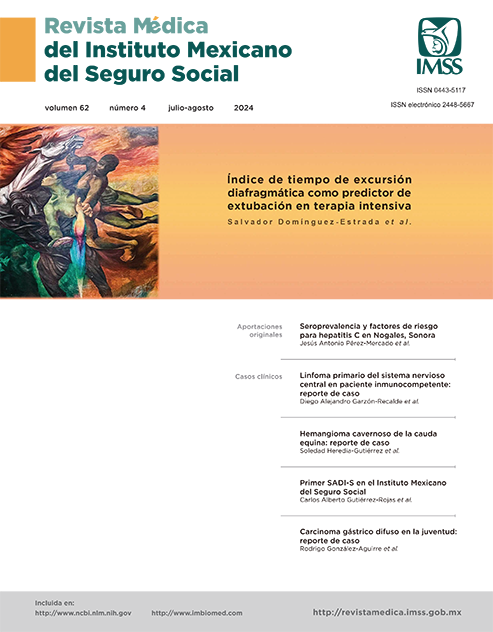Electromyography in atypical variants of motor neuron disease: a case series
Main Article Content
Keywords
Motoneurone Disease, Amyotrophic Lateral Sclerosis, Neurophysiology, Electromyography
Abstract
Background: Amyotrophic lateral sclerosis (ALS) is a neurodegenerative disease that affects both the upper and lower motor neurons, it has a heterogeneous clinical presentation, there are atypical variants that differ from the classic form of the disease. The criteria for diagnosis have evolved over time, with the support of electromyography (EMG), we present a patient series with these variants in which EMG was crucial to make the diagnosis.
Clinical cases: Six cases are described with atypical presentation of motor neuron disease, for the isolated bulbar ALS phenotype, three cases are reported: two male patients (68 and 62 years old) and one woman (33 years old), with initial symptoms in the bulbar segment and late progression. to a second segment, corroborating characteristic findings by EMG. For the variant of Vulpian-Bernhardt syndrome (VBS), two male patients aged 82 and 72 years are reported, with initial symptoms in the thoracic segment with electromyographic support for the diagnosis; finally, a case of amyotrophic diplegia of the legs (APD) is described in a 50-year-old female patient with symptoms isolated to the pelvic limbs, with a slow clinical evolution, corroborated by EMG with involvement of other spinal segments.
Conclusions: ALS is part of the spectrum of motor neuron diseases, a neurodegenerative disease of the central nervous system, without curative treatment and with a fatal outcome. The diagnosis of ALS is complex and becomes more complicated for atypical phenotypes, as observed in the cases presented, EMG is an essential part of the approach and is part of the most recent diagnostic criteria.
References
Hardiman O, Al-Chalabi A, Chio A, et al. Amyotrophic lateral sclerosis. Nat Rev Dis Primers. 2017;3:17071. doi: 10.1038/ nrdp.2017.71.
Mejzini R, Flynn LL, Pitout IL, et al. ALS Genetics, Mechanisms, and Therapeutics: Where Are We Now? Front Neurosci. 2019;13:1310. doi: 10.3389/fnins.2019.01310.
Martínez HR, Molina-López JF, Cantú-Martínez L, et al. Survival and clinical features in Hispanic amyotrophic lateral sclerosis patients. Amyotroph Lateral Scler. 2011;12(3):199-205. doi: 10.3109/17482968.2010.550302.
Sánchez-Martínez CM, Choreño-Parra JA, Nuñez-Orozco L, et al. A retrospective study of the clinical phenotype and predictors of survival in non-Caucasian Hispanic patients with amyotrophic lateral sclerosis. BMC Neurol. 2019;19(1):261. doi: 10.1186/s12883-019-1459-3.
Pinto WBVR, Debona R, Nunes PP, et al. Atypical Motor Neuron Disease variants: Still a diagnostic challenge in Neurology. Rev Neurol (Paris). 2019;175(4):221-232. doi: 10.1016/j. neurol.2018.04.016.
Turner MR. Diagnosing ALS: The Gold Coast criteria and the role of EMG. Pract Neurol. 2022;22(3):176-178. doi: 10.1136/ practneurol-2021-003256.
de Carvalho M, Dengler R, Eisen A, et al. Electrodiagnostic criteria for diagnosis of ALS. Clin Neurophysiol. 2008;119(3):497- 503. doi: 10.1016/j.clinph.2007.09.143.
Aguilar-Vázquez CA, Aguilar-Castillo SJ, Raymundo-Carrillo AD. Apoyo del electrodiagnóstico en una forma atípica de esclerosis lateral amiotrófica (síndrome de Vulpian-Bernhardt). Rev Med Inst Mex Seguro Soc. 2024;62(1):e5318. doi: 10.5281/ zenodo.10278187.
Marin B, Fontana A, Arcuti S, et al. Age-specific ALS incidence: a dose-response meta-analysis. Eur J Epidemiol. 2018; 33(7):621-634. doi: 10.1007/s10654-018-0392-x.
Xu L, Liu T, Liu L, et al. Global variation in prevalence and incidence of amyotrophic lateral sclerosis: a systematic review and meta-analysis. J Neurol. 2020;267(4):944-953. doi: 10.1007/s00415-019-09652-y.
Goutman SA, Hardiman O, Al-Chalabi A, et al. Recent advances in the diagnosis and prognosis of amyotrophic lateral sclerosis. Lancet Neurol. 2022;21(5):480-493. doi: 10.1016/ S1474-4422(21)00465-8.
Masrori P, Van Damme P. Amyotrophic lateral sclerosis: a clinical review. Eur J Neurol. 2020;27(10):1918-1929. doi: 10.1111/ ene.14393.
Feldman EL, Goutman SA, Petri S, et al. Amyotrophic lateral sclerosis. Lancet. 2022;400(10360):1363-1380. doi: 10.1016/ S0140-6736(22)01272-7.
López-Hernández JC, Bazán-Rodríguez L, Pérez-Torres T, et al. Síndrome de Vulpian-Bernhardt. Frecuencia, características clínicas y electrofisiológicas en un centro de atención de tercer nivel en México. Rev Neurol 2021;72 (03):85-91. doi: 10.33588/ rn.7203.2020126.
Zhang H, Chen L, Tian J, et al. Differentiating Slowly Progressive Subtype of Lower Limb Onset ALS From Typical ALS Depends on the Time of Disease Progression and Phenotype. Front Neurol. 2022;13:872500. doi: 10.3389/fneur.2022.872500.
Xu Y, Chen J, Zhang S, et al. Upper Motor Neuron Signs in the Cervical Region of Patients With Flail Arm Syndrome. Front Neurol. 2021;12:610786. doi: 10.3389/fneur.2021.610786.
Maranzano A, Verde F, Colombo E, et al. Regional spreading pattern is associated with clinical phenotype in amyotrophic lateral sclerosis. Brain. 2023;146(10):4105-4116. doi: 10.1093/ brain/awad129.
He Z, Sun B, Feng F, et al. Time of symptoms beyond the bulbar region predicts survival in bulbar onset amyotrophic lateral sclerosis. Neurol Sci. 2022;43(3):1817-1822. doi: 10.1007/ s10072-021-05556-w.
Jawdat O, Statland JM, Barohn RJ, et al. Amyotrophic Lateral Sclerosis Regional Variants (Brachial Amyotrophic Diplegia, Leg Amyotrophic Diplegia, and Isolated Bulbar Amyotrophic Lateral Sclerosis). Neurol Clin. 2015;33(4):775-85. doi: 10.1016 /j.ncl.2015.07.003.
Vucic S, Ferguson TA, Cummings C, et al. Gold Coast diagnostic criteria: Implications for ALS diagnosis and clinical trial enrollment. Muscle Nerve. 2021;64(5):532-537. doi: 10.1002/ mus.27392.
Hannaford A, Pavey N, van den Bos M, et al. Diagnostic Utility of Gold Coast Criteria in Amyotrophic Lateral Sclerosis. Ann Neurol. 2021;89(5):979-986. doi: 10.1002/ana.26045.
Kwan J, Vullaganti M. Amyotrophic lateral sclerosis mimics. Muscle Nerve. 2022;66(3):240-252. doi: 10.1002/mus.27567.


